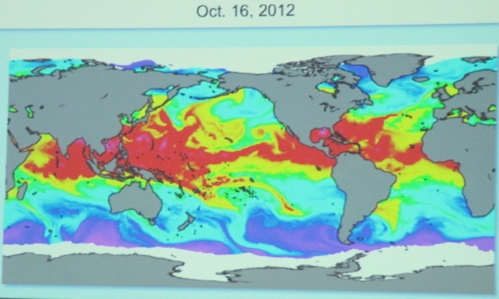UC Blogs
Debut Event of UC Davis Honey and Pollination Center
If you want to know more about honey and pollination, then mark your calendar for Saturday, Oct. 27. That's the date of the debut event of the newly...
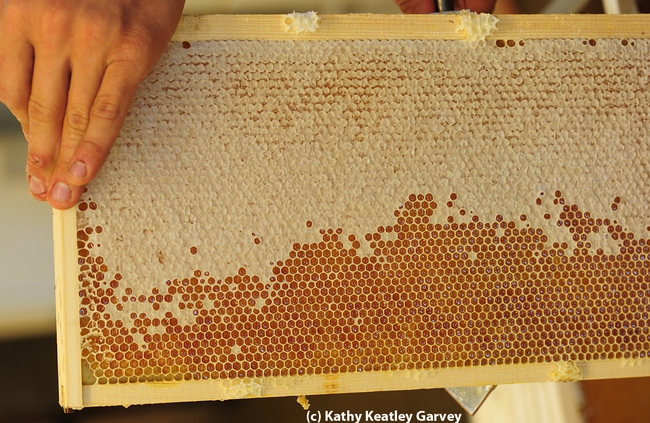
A frame of honey from the Harry H. Laidlaw Jr. Honey Bee Research Facility, UC Davis. (Photo by Kathy Keatley Garvey)
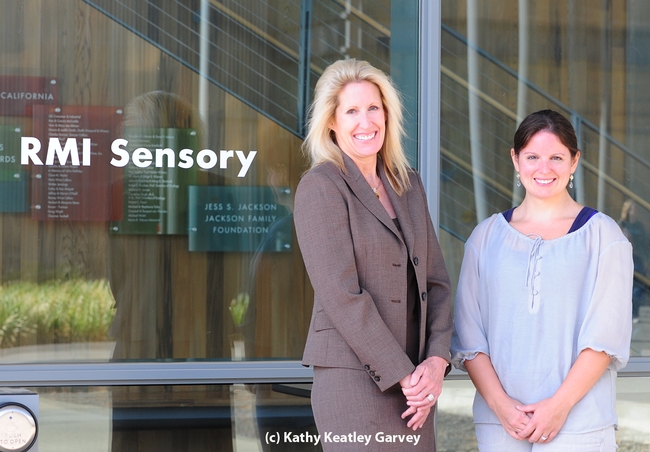
Ready to greet visitors are RMI executive director Clare Hasler-Lewis (left) and event coordinator Tracy Dickinson. (Photo by Kathy Keatley Garvey)
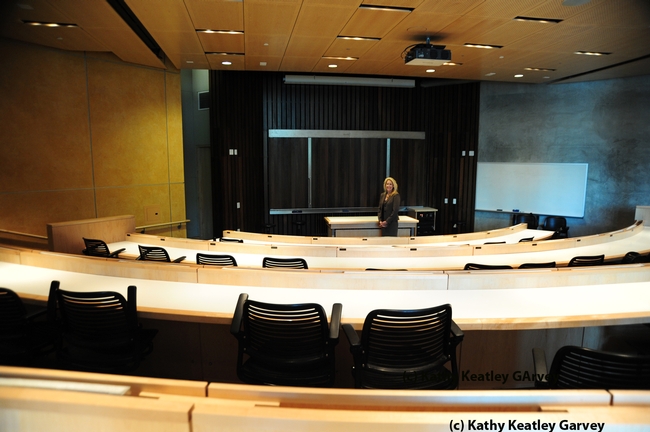
RMI executive director Clare Hasler-Lewis at the RMI's Silverado Vineyards Sensory Theatre. (Photo by Kathy Keatley Garvey)
UC's red walnut featured in Fresno Bee
The lead food story in the Fresno Bee this week focused on walnuts and their local availability. An important component of the story was the red walnut, a cultivar developed by University of California breeders a decade ago.
Most walnuts grown in California have a light tan seed coat. The "Robert Livermore" walnut has a red seed coat.
"It has a very interesting color and gives consumers and farmers another option," said Chuck Leslie, staff research associate in the Department of Plant Sciences at UC Davis.
Leslie says the nut does not taste significantly different than ordinary walnuts to him. Fresno Bee reporter Robert Rodriguez quoted a Sacramento food blogger in the story who said the red walnut has a milder flavor and works well in recipes ranging from salads to cookies.
UC's red walnut was named after the late Lake County walnut grower Robert Livermore, said Rachel Elkins, UC Cooperative Extension advisor for Lake and Mendocino counties. The Livermore family owns a historic ranch on Mt. St. Helena that is still in operation.
"Robert Livermore contributed to the breeding program and hence the walnut was named for him," Elkins said. "He managed the Bishop Ranch in San Ramon which is now a large commercial business park, but was a very large fruit and nut ranch."
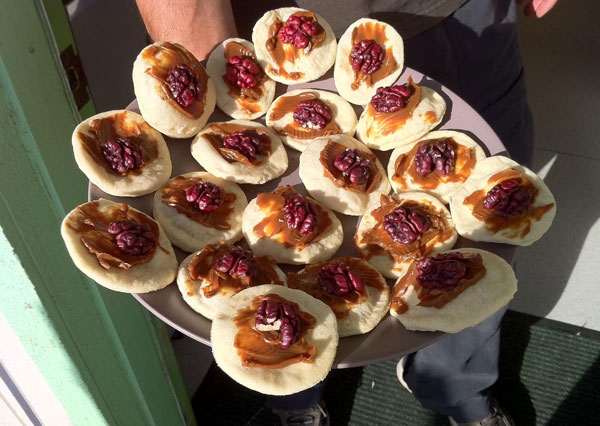
Red walnuts brighten up a plate of cookies.
Crape Myrtle Madness
When our family moved from the Bay Area to Vacaville five years ago, I looked forward to warm fog-less summers sitting beside the swimming pool in our small backyard. But I found out that sitting is a rare occurrence since seven 20-year old Redwood trees (Sequoia sempervirens) and three Crape myrtles (Lagerstoemia indica) border the pool. When my husband and I aren't scooping out cones and needles, we're glaring at the myrtle trees bursting with aerodynamic blooms fit for the slightest breeze.
We determined that this year would be different. By late-July we hatched a plan to conquer the blossom drop. Before the petals started falling, we started pruning. One by one, flower clusters plopped onto the walkway. By day’s end our green-waste can sat at the curb like a stuffed Thanksgiving turkey. My husband and I sank into our faux wicker chairs with pretzels and cokes in hand. We grinned from ear to ear, thrilled that these skinny-dipping blossoms were history. Finally, time to relax.
“Hey, Honey, we'll have a clean pool for a couple months before the autumn winds shake down the dead redwood needles,” I told my husband.
Wrong. By Labor day, I was staring at Crape myrtle buds—again. In fact, they sprouted from every single cut our pruners had made and by mid-September the trees were thick with flowers. Oops, I had unknowingly coaxed a second bloom out of the trees. Next year we'll return to our usual once-a-year early spring pruning regime of removing the prior year’s seed capsules, enjoying the flower show—and putting up with the maddening scattering mess.

Crape myrtle buds. (photos by Launa Herrmann)

Crape myrtle blooms.
A Bug-Eat-Bug World
It's a bug-eat-bug world out there. Today we watched a syrphid fly, aka "hover fly" and "flower fly," circling a blanket flower (Gaillardia) and...
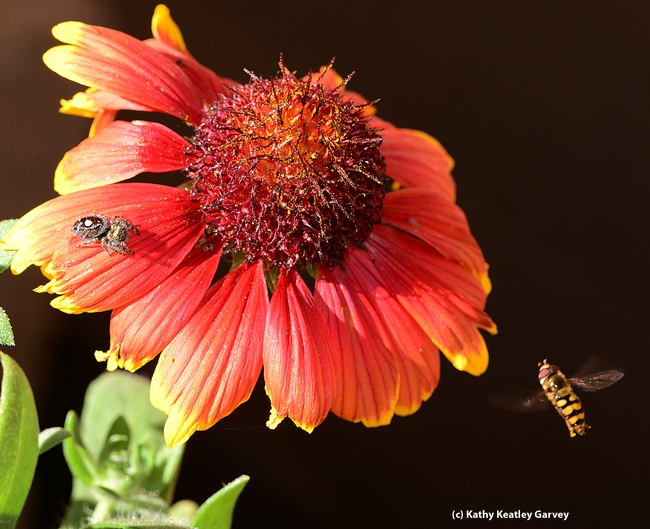
Syrphid fly (right) circles a blanket flower, unaware of the jumping spider. (Photo by Kathy Keatley Garvey)
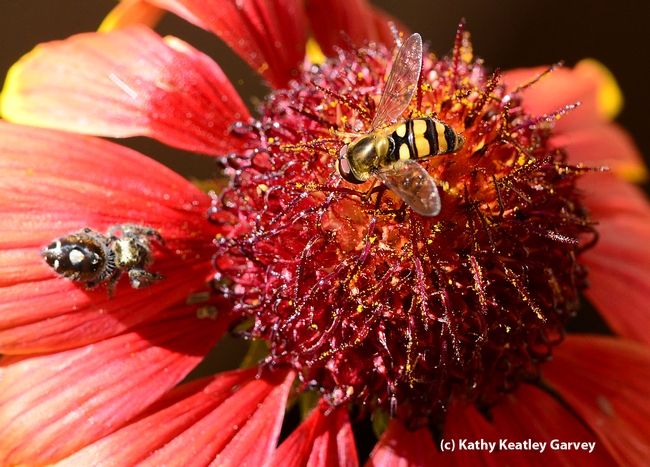
Syrphid fly sipping nectar close to the predator. (Photo by Kathy Keatley Garvey)

End result--the jumping spider feasting on the syrphid fly. (Photo by Kathy Keatley Garvey)
Climate is indeed an angry beast
Global warming promises to be among the most immense challenges to human adaptation in history, as big as social media. But the climate topic has been overshadowed in recent years by the recession. Just as the Dow Jones can’t be described by the fluctuations of a single decade, climate science is not defined by periods less than centuries.
These thoughts were shared at a breakfast Oct. 16 at UC Davis hosted by Capital Public Radio. The speaker: Ben Santer, MacArthur Fellow (1998), National Academy Member (2012), and atmospheric scientist at Lawrence Livermore National Laboratory.
Santer said that when he hears about the tragedy of burdening youth with the national debt, he would like to hear more about the burdening of youth with global climate change. The verbal references have vaporized.
It was appropriate that Santer opened his talk with a graphic depicting changes in global water vapor, the greenhouse gas that Earth relies on to sustain its water cycles. This greenhouse gas inspired 10,000 years of human supplication to climate gods that could meet their need for rain. But he didn’t come to talk about the largely unpredictable weather (he calls this noise), except as an indicator of a more predictable long-term climate trend (he calls this the signal). Scientists have methods to work out the signal to noise ratio and finding the major trends among frequent short-term fluctuations.
Santer has been involved with the IPCC since 1990. It wasn’t until 1995 that this international mouthpiece of global climate science announced that the evidence suggested that there was a human influence on global climate.
To his surprise, Santer spent the next year and a half defending that cautionary statement, and his research role turned into that of a messenger. Two more IPCC reports and 17 years later, he is still confirming human influences through testimony to the U.S. House of Representatives’ Committee on Global Warming (2010). His message remains the same, “Climate science is not a scam, a hoax, or a conspiracy.” It is not a belief system, so he doesn’t have to “believe in it.” He does believe in scientific facts, and proving hypotheses. His graphics make a strong case for the science, but his research problem is one of communication. He resolved to talk to everyone he meets about it.
His advice, when asked this question from the audience, would be to make the U.S. a leader in solutions rather than a leader in finger pointing. He believes that the leaders who make economic decisions based on climate science will be better able to adapt and manage the impending change, however placing blame on other nations is counterproductive to this goal.
What can we expect from the next IPCC global climate report? Santer predicts that there will be a downsizing of scale to regional scenarios. Following sage advice, if the problem is too big, break it down. His last word, a quote from climate scientist Wally Broecker, “Climate is an angry beast and we are poking it with a sharp stick.”



